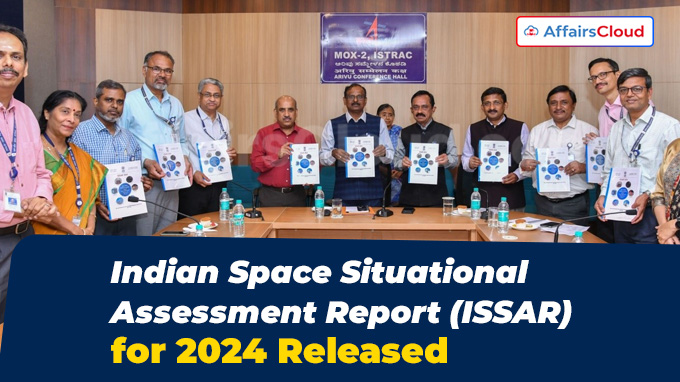 In May 2025, Dr. V. Narayanan, Chairman of Bengaluru (Karnataka)-based Indian Space Research Organisation (ISRO)/ Secretary of Department of Space (DOS), released the’ Indian Space Situational Assessment Report (ISSAR) for 2024’, compiled annually by ISRO System for Safe and Sustainable Space Operations Management (IS4OM).
In May 2025, Dr. V. Narayanan, Chairman of Bengaluru (Karnataka)-based Indian Space Research Organisation (ISRO)/ Secretary of Department of Space (DOS), released the’ Indian Space Situational Assessment Report (ISSAR) for 2024’, compiled annually by ISRO System for Safe and Sustainable Space Operations Management (IS4OM).
- ISRO performs Space Situational Awareness (SSA) activities to protect India’s space assets against various environmental risks like: Resident Space Objects which includes space debris; or natural objects like: asteroids and meteoroids, energy and particle flux.
- IS4OM acts as a nodal agency to concert all space sustainability efforts, including SSA activities, and to enhance compliance with globally recognized guidelines on the long-term sustainability of outer space activities.
India-Specific:
i.A total of 136 Indian spacecraft, including those from private operators/academic institutions, were launched in Earth-orbit till December 31, 2024.
- By the end of December 2024, the total number of operational satellites owned by Government of India (GoI) is 22 in Low Earth Orbit (LEO) and 31 in Geo-synchronous Earth Orbit (GEO).
ii.Additionally, 2 Indian deep space missions namely, Chandrayaan-2 Orbiter (CH20) and Aditya-L1 at Sun-Earth Lagrange’s point were also operational.
- The propulsion module of Chandrayaan-3 space continued to function in a high earth orbit i.e. more than 1 lakh kilometer (km) away, after being relocated from its lunar orbit since 2023.
iii.In 2024, there were 5 launches from Sriharikota (Andhra Pradesh, AP), namely
- Polar Satellite Launch Vehicle (PSLV-C58)/ X-ray Polarimeter Satellite (XPoSat);
- PSLV-C59/ PROBA-3;
- PSLV-C60/SPADEX;
- GSLV-F14/INSAT-3DS; and
- 3rd edition of the Small Satellite Launch Vehicle – Earth Observation Satellite (SSLV-D3/EOS-08)
iv.A total of 15 satellites were launched, including 8 Indian satellites, 1 foreign satellite and 6 rocket bodies, which includes PSLV Orbital Experimental Module-3 (POEM-3) and POEM-4, were deployed in their intended orbits.
v.By the end of December 2024, a total of 34 rocket bodies re-entered the Earth’s atmosphere, of which, 5 were re-entered in 2024 alone.
- Also, a total of 31 Indian satellites have re-entered the atmosphere till December 31, 2024, of which, 9 Indian satellites re-entered in the year 2024 alone.
- Among these 9 satellites, Cartosat-2 re-entered the earth’s atmosphere in February 2024, ISRO’s 1st ever LEO satellite to be de-orbited at end-of-life to reduce its post-mission orbital life from over 30 to less than 4 years.
Collision Avoidance Manoeuvres (CAM):
i.According to the report, ISRO successfully performed 10 Collision Avoidance Manoeuvres (CAMs) in 2024. Out of these 10 CAMs, ISRO carried out 6 CAMs in Low Earth Orbit (LEO) and remaining 4 in Geosynchronous Earth Orbit (GEO).
- However, this number is less compared to 23 CAMs carried out by ISRO in 2023.
- In the last 14 years, ISRO has conducted 122 CAMs for its earth-orbiting satellites.
ii.ISRO received over 53000 alerts by the Combined Space Operations Center (CSpOC), United States of America (USA)-led multinational space operations center for its satellites, which were examined using data from flight dynamics resulting in 10 anomalies.
iii.In 2024, 89 manoeuvre plans were revised to avoid post-manoeuvre close approaches with other space objects specifically for LEO satellites. While, 2 manoeuvre plans were revised to avoid post-manoeuvre conjunctions for GEO satellites.
Global Scenario:
i.Highest Number of Launches in 2024: As per the report, a total of 2,963 space objects were placed into orbit globally, resulting from 261 launch attempts, of which 254 were successful, which resulted in an addition of 2578 operational satellites.
- However, this number was less compared to 3135 objects from 212 launches in 2023.
ii.Lunar Missions: In 2024, 5 lunar missions were launched, indicative of the renewed interest in lunar exploration.
iii.On-orbit break-up events: The report revealed that there were 3 major on-orbit break-up events occurred in 2024 and one of them, was the fragmentation of a Long March rocket stage (CZ-6A) which added 650 catalogued objects.
- Some of these fragments decayed within same year which further resulted in a total addition of 702 fragmented objects to the total space debris by December 2024, which was higher than 69 (in 2023).
- Thus, a total of 3665 objects from 254 launches and on-orbit break-up events were added to the space object population.
iii.Catalogued Objects Re-entered the Atmosphere: In 2024, a total of 2095 catalogued objects re-entered the atmosphere, out of them, 335 objects were Starlink satellites.
Debris Free Space Mission (DFSM):
i.ISRO chaired the Inter-Agency Debris Coordination Committee (IADC) for the period of 2023-24 and hosted the 42nd annual IADC meet held in April 2024 in Bengaluru (Karnataka).
ii.During the 42nd IADC annual meet, India announced the launch of Debris Free Space Mission (DFSM) which aims for debris-free space missions by all Indian space agencies, including governmental and non-governmental, by 2030.
iii.Recognizing the vital role of Space Situational Awareness (SSA), ISRO launched Project NETRA (Network for Space Object Tracking and Analysis).The initiative aims to develop indigenous capabilities to monitor, track, and analyze space objects and debris.
Major ISRO Centres:
- Vikram Sarabhai Space Centre (VSSC), Thiruvananthapuram, Kerala – Specializes in the development of launch vehicles and rocket technologies.
- U.R. Rao Satellite Centre (URSC), Bengaluru, Karnataka – Responsible for satellite design, development, and integration.
- Satish Dhawan Space Centre (SDSC), Sriharikota, Andhra Pradesh(AP) – India’s primary launch site for satellites and rockets.
- Liquid Propulsion Systems Centre (LPSC), Valiamala (Kerala) & Bengaluru (Karnataka) – Engaged in the development of liquid and cryogenic propulsion systems.
- National Remote Sensing Centre (NRSC), Hyderabad, Telangana – Manages satellite data acquisition, processing, and remote sensing applications.
- Space Applications Centre (SAC), Ahmedabad, Gujarat – Focuses on the development of communication, meteorological, and remote sensing payloads.




